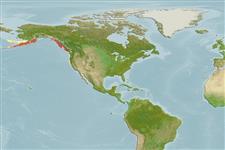Teleostei (teleosts) >
Perciformes/Cottoidei (Sculpins) >
Cottidae (Sculpins)
Etymology: Ruscarius: Latin, ruscarius, -a- um = with tangled hair; meanyi: Named after Prof. E.S. Meany of the University of Washington (Ref. 6885).
Eponymy: Edmond Stephen Meany (1862–1935) was Professor of Botany and History and became Secretary of the University of Washington, from which he graduated (1885) and where the theatre is named after him. [...] (Ref. 128868), visit book page.
More on authors: Jordan & Starks.
Environment: milieu / climate zone / depth range / distribution range
Ecology
Marine; demersal; depth range 2 - 82 m (Ref. 2850). Temperate; 59°N - 38°N
Eastern Pacific: Fillmore Island, southeastern Alaska to Arena Cove, northern California, USA.
Size / Weight / Age
Maturity: Lm ? range ? - ? cm
Max length : 5.9 cm TL male/unsexed; (Ref. 2850)
Inhabits intertidal and subtidal areas, on rocks or vertical rock faces (Ref. 2850).
Life cycle and mating behavior
Maturity | Reproduction | Spawning | Eggs | Fecundity | Larvae
Matarese, A.C., A.W. Kendall, D.M. Blood and M.V. Vinter, 1989. Laboratory guide to early life history stages of Northeast Pacific fishes. NOAA Tech. Rep. NMFS 80:1-652. (Ref. 265)
IUCN Red List Status (Ref. 130435: Version 2024-1)
Threat to humans
Harmless
Human uses
Tools
Special reports
Download XML
Internet sources
Estimates based on models
Preferred temperature (Ref.
123201): 5.6 - 10.7, mean 8.6 °C (based on 120 cells).
Phylogenetic diversity index (Ref.
82804): PD
50 = 0.7500 [Uniqueness, from 0.5 = low to 2.0 = high].
Bayesian length-weight: a=0.00794 (0.00386 - 0.01635), b=3.12 (2.95 - 3.29), in cm total length, based on LWR estimates for this (Sub)family-body shape (Ref.
93245).
Trophic level (Ref.
69278): 3.2 ±0.5 se; based on size and trophs of closest relatives
Resilience (Ref.
120179): High, minimum population doubling time less than 15 months (Preliminary K or Fecundity.).
Fishing Vulnerability (Ref.
59153): Low vulnerability (10 of 100).
